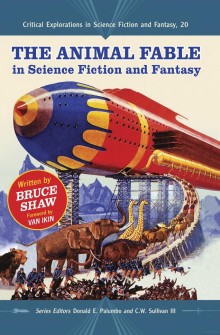Review: 'The Animal Fable in Science Fiction and Fantasy', by Bruce Shaw
 Academia strikes again. This scholarly study, #20 in the McFarland’s “Critical Explorations in Science Fiction and Fantasy” series, edited by Donald E. Palumbo and C. W. Sullivan III, presents a literary and historical analysis of the theme of intelligent animals in modern (20th) century science fiction and fantasy.
Academia strikes again. This scholarly study, #20 in the McFarland’s “Critical Explorations in Science Fiction and Fantasy” series, edited by Donald E. Palumbo and C. W. Sullivan III, presents a literary and historical analysis of the theme of intelligent animals in modern (20th) century science fiction and fantasy.
Though animal stories and fables stretch back into the antiquity of ancient India, Persia, Greece and Rome, the reasons for writing them and their resonance for readers (and listeners) remain consistent to the present. This work argues that they were essential sources of amusement and instruction--and were also often profoundly unsettling. Such authors in the realm of the animal fable as Tolkien, Freud, Voltaire, Bakhtin, Cordwainer Smith, Karel ?apek, Vladimir Propp, and many more are discussed. (back-cover blurb)
McFarland & Co., April 2010, trade paperback $35.00 (vii + 260 pages). Foreword by Van Ikin.
Shaw begins with a brief discussion of the Beast Fable and the Animal Fable, from prehistoric times through Lucius Apuleius’ The Golden Ass (late 2nd century A.D.), the medieval Romance of Reynard the Fox (12th c.), Geoffrey Chaucer’s The Nun’s Priest’s Tale (1386-87), Wu Ch’eng-en’s Monkey (1590s), the animal fables of Jean de La Fontaine (17th c.), and lots of 19th and 20th-century examples. Shaw next lists the scholars who have analyzed these fables and the importance of intelligent animals in literature, named in the blurb, and summarizes their arguments, focusing on 'dialogism versus monologism, polyglossia, and carnivalization'?(p.?19)
The chapters “The Lineage of the Animal Fable”, “Recasting the Animal Fable: Short Stories”, and “Recasting the Animal Fable: Novels and Novellas” briefly mention 19th and 20th century examples in general literature, such as Lewis Carroll’s Alice’s Adventures in Wonderland (1865), Anatole France’s Penguin Island (1908), Saki’s Tobermory (1911), and Franz Kafka’s The Metamorphosis (1917); some previous related studies (Eugene La Faille’s 1984 Pawprints Across the Galaxy: Dogs in Science Fiction); and lots and LOTS of s-f stories with intelligent animals. David Brin, Philip K. Dick, and Andre Norton are frequently cited. Other authors include Poul Anderson (Brain Wave), Fredric Brown (Star Mouse), Lester del Rey (The Faithful), Gordon Dickson (Dolphin’s Way), Daniel Keyes (Flowers for Algernon), William Kotzwinkle (Doctor Rat), Anne McCaffrey (Decision at Doona), Ian McDonald (Floating Dogs), J. T. McIntosh (The Fittest), Will Self (Great Apes) – too many to list.
Though many authors and stories are mentioned, Shaw examines six in depth: Mikhail Bulgakov and The Heart of a Dog (1925), Karel ?apek and War with the Newts (1936), Olaf Stapledon and Sirius (1944; review), Clifford Simak and City (1952), Cordwainer Smith and The Dead Lady of Clown Town (1964), and Peter Goldsworthy and Wish (1995). Shaw first presents a chapter of biographies of these authors, placing them within their societies, and then analyses – you might say that he dissects – each work. These chapters run for over 120 pages of this 260 page book.
As is de rigueur for any critical analysis, there are an extensive bibliography and index.
For those interested in further Critical Explorations in Science Fiction and Fantasy, there is a list of the 23 volumes in this series (Ed: now 33). Some sample titles are Science Fiction from Quebec: A Postcolonial Study by Amy J. Ransom (#15), and Ursula K. Le Guin’s Journey to Post-Feminism by Amy M. Clarke (#18). Further details may be had at McFarland's website, or from (800) 253-2187. I am tempted to contact the editors and propose a scholarly analysis of the literature of Furry fandom, with emphasis on the works of our specialty publishers and their authors. Hey, if I don’t, someone else eventually will.
The Animal Fable in Science Fiction and Fantasy has an excellent reproduction of the cover of Startling Stories, November 1939 as its cover. What’s this about 'artist unknown', though? It’s Howard V. Brown! I thought that everybody knew that. Brown (1878-1945) was one of the most popular and prolific s-f pulp cover artists of the 1930s, and this is one of his most famous covers!
About the author
Fred Patten — read stories — contact (login required)a retired former librarian from North Hollywood, California, interested in general anthropomorphics
Comments
Picking this one up.
I'm tempted to myself. Maybe a wishlist item.
Of course, it could be a bit dry; you might do even better buying the books referenced.
I like dry criticism of books I haven't read. I can't count the times I've read H.P. Lovecraft's "The Supernatural in Literature," and it doesn't get much drier than Lovecraftian essays.
Still don't have much desire to read "The Castle of Otranto," partially because all the dry essays I've read on it.
Post new comment